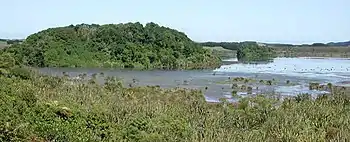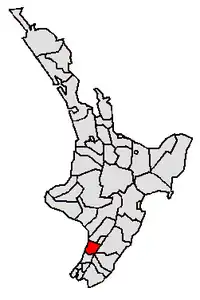Horowhenua District
Horowhenua District is a territorial authority district on the west coast of the North Island of New Zealand, administered by Horowhenua District Council. Located north of Wellington and Kāpiti, it stretches from slightly north of the town of Ōtaki in the south to just south of Himatangi in the north, and from the coast to the top of the Tararua Range. It is in the Manawatū-Whanganui local government region. The name Horowhenua is Māori for landslide.[3]
Horowhenua District | |
|---|---|
 Lake Papaitonga | |
 | |
| Coordinates: 40°35′20″S 175°20′35″E | |
| Country | New Zealand |
| Region | Manawatū-Whanganui |
| Wards | Levin Waiopehu Miranui Kere Kere |
| Seat | Levin |
| Government | |
| • Mayor | Bernie Wanden |
| • Deputy Mayor | Jo Mason |
| • Territorial authority | Horowhenua District Council |
| Area | |
| • Total | 1,063.91 km2 (410.78 sq mi) |
| Population (June 2023)[2] | |
| • Total | 37,500 |
| • Density | 35/km2 (91/sq mi) |
| Time zone | UTC+12 (NZST) |
| • Summer (DST) | UTC+13 (NZDT) |
| Website | www |
Levin is the main town and the seat of the district council. Other towns include Foxton, Shannon and Tokomaru. The population of the district is 37,500 (June 2023).[2]
History
Horowhenua County was established in 1885 from the southern part of Manawatu County. It stretched from the Manawatū River, Opiki and Tokomaru in the north, to Waikanae and the Waikanae River in the south.[4] The county offices were in Ōtaki until 1896, when they were moved to Levin.[5]
Horowhenua District was established in 1989 from a merger of Horowhenua County, Foxton Borough, Levin Borough and part of the first Manawatū District, as part of New Zealand local government reforms. The southern part of Horowhenua County – the Waikanae and Otaki areas – became part of Kāpiti Coast District.[5]
Populated places
Horowhenua District consists of the following towns, localities, settlements and communities (larger towns shown in bold):
|
Demographics
Horowhenua District covers 1,063.91 km2 (410.78 sq mi)[1] and had an estimated population of 37,500 as of June 2023,[2] with a population density of 35 people per km2.
| Year | Pop. | ±% p.a. |
|---|---|---|
| 2006 | 29,868 | — |
| 2013 | 30,096 | +0.11% |
| 2018 | 33,261 | +2.02% |
| Source: [6] | ||
Horowhenua District had a population of 33,261 at the 2018 New Zealand census, an increase of 3,165 people (10.5%) since the 2013 census, and an increase of 3,393 people (11.4%) since the 2006 census. There were 13,230 households, comprising 16,143 males and 17,118 females, giving a sex ratio of 0.94 males per female. The median age was 46.8 years (compared with 37.4 years nationally), with 6,087 people (18.3%) aged under 15 years, 5,244 (15.8%) aged 15 to 29, 13,707 (41.2%) aged 30 to 64, and 8,223 (24.7%) aged 65 or older.
Ethnicities were 81.0% European/Pākehā, 24.5% Māori, 5.7% Pasifika, 4.1% Asian, and 1.6% other ethnicities. People may identify with more than one ethnicity.
The percentage of people born overseas was 14.1, compared with 27.1% nationally.
Although some people chose not to answer the census's question about religious affiliation, 51.1% had no religion, 36.0% were Christian, 1.3% had Māori religious beliefs, 0.4% were Hindu, 0.1% were Muslim, 0.4% were Buddhist and 1.6% had other religions.
Of those at least 15 years old, 2,877 (10.6%) people had a bachelor's or higher degree, and 7,806 (28.7%) people had no formal qualifications. The median income was $23,900, compared with $31,800 nationally. 2,337 people (8.6%) earned over $70,000 compared to 17.2% nationally. The employment status of those at least 15 was that 10,905 (40.1%) people were employed full-time, 3,567 (13.1%) were part-time, and 1,311 (4.8%) were unemployed.[6]
| Name | Area (km2) | Population | Density (per km2) | Households | Median age | Median income |
|---|---|---|---|---|---|---|
| Kere Kere Ward | 242.87 | 5,949 | 24.49 | 2,430 | 48.8 years | $23,700 |
| Miranui Ward | 299.82 | 3,189 | 10.64 | 1,170 | 37.0 years | $27,100 |
| Levin Ward | 14.71 | 17,133 | 1,164.72 | 6,837 | 45.4 years | $22,500 |
| Waiopehu Ward | 506.50 | 6,990 | 13.80 | 2,790 | 51.7 years | $29,000 |
| New Zealand | 37.4 years | $31,800 |
Land use
Much of the area was once an extensive wetland and the centre of a substantial flax industry. It has been progressively drained and converted to productive but flood-prone farmland, with a mixture of loam and peat based soils. Some parts of the wetland, particularly those around Lake Horowhenua are being returned to their former state as a conservation area, with the help of local Māori. One of the local tribal authorities is the Muaūpoko Tribal Authority.
Museums
- Te Awahou Nieuwe Stroom – Foxton
- Piriharakeke Generation Inspiration Centre – Foxton
- Oranjehof Dutch Connection Centre – Foxton
- Flax Stripper Museum – Foxton
- MAVTech – Museum of Audiovisual Technology – Foxton
Schools
Secondary:
- Manawatū College, Foxton
- Horowhenua College, Levin
- Waiopehu College, Levin
Primary:
- Foxton Beach School, Foxton Beach
- Coley Street School, Foxton
- Foxton Primary, Foxton
- St. Marys, Foxton
- Levin East School, Levin
- Fairfield School, Levin
- Ohau School, Ohau (Levin Rural)
- Koputuroa School, Levin Rural
- St. Josephs, Levin
- Levin School, Levin
- Levin North School, Levin
- Taitoko School, Levin
- Poroutawhao School, Levin Rural
- Shannon School, Shannon
- Manakau School, Manakau
- Opiki School, Opiki
- Tokomaru School, Tokomaru
Intermediate:
- Levin Intermediate, Levin
Sport
In rugby, a combined Horowhenua-Kapiti team represents the area in the amateur Heartland Championship.
In cricket, a Horowhenua-Kapiti team has competed in the Hawke Cup since 2002.
References
- "ArcGIS Web Application". statsnz.maps.arcgis.com. Retrieved 6 March 2022.
- "Subnational population estimates (RC, SA2), by age and sex, at 30 June 1996-2023 (2023 boundaries)". Statistics New Zealand. Retrieved 25 October 2023. (regional councils); "Subnational population estimates (TA, SA2), by age and sex, at 30 June 1996-2023 (2023 boundaries)". Statistics New Zealand. Retrieved 25 October 2023. (territorial authorities); "Subnational population estimates (urban rural), by age and sex, at 30 June 1996-2023 (2023 boundaries)". Statistics New Zealand. Retrieved 25 October 2023. (urban areas)
- Reed, A. W. (2002). The Reed Dictionary of New Zealand Place Names. Auckland: Reed Books. p. 212. ISBN 0-7900-0761-4.
- "Map of Horowhenua County". Archives Central. Manawatū-Whanganui Local Authority Shared Services. Retrieved 13 August 2022.
- "Horowhenua County Council". Archives Central. Manawatū-Whanganui Local Authority Shared Services. Retrieved 13 August 2022.
- "Statistical area 1 dataset for 2018 Census". Statistics New Zealand. March 2020. Horowhenua District (042). 2018 Census place summary: Horowhenua District